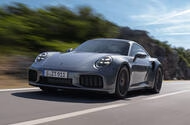How Does the New Hybrid Porsche 911 Turbo S Redefine Performance?
When Porsche decides to shake up its iconic 911 Turbo S, the world pays attention. This time, the legendary sports car takes a bold leap into hybrid territory, and the result is nothing short of electrifying—literally and figuratively. The 2025 Porsche 911 Turbo S is now the most powerful 911 ever, breaking the 700bhp barrier and introducing a host of technical innovations that promise to change the way we think about high-performance driving.
What’s Actually New Under the Hood?
Let’s get straight to the heart of the matter: the engine. Porsche has swapped out the previous 3.7-litre flat-six for a reworked 3.6-litre unit, closely related to the one found in the 911 Carrera GTS hybrid. But this isn’t just a simple engine swap. The new powerplant features asymmetric valve timing and new pistons for a higher compression ratio, plus a clever new addition—an ‘eTurbo’ system.
So, what does all this mean in real-world terms? The new Turbo S cranks out a staggering 701bhp between 6500rpm and 7000rpm—up from 641bhp in the outgoing model. Torque remains at 590lb ft, but the way it’s delivered is a game-changer. Thanks to the hybrid system, you get a much broader, flatter torque curve, translating to relentless acceleration at almost any speed.
How Does Porsche’s T-Hybrid System Work?
Hybrid systems in sports cars can be a mixed bag, but Porsche’s T-Hybrid setup is anything but ordinary. Instead of focusing on pure electric range, the system is all about performance. A compact 1.9kWh battery sits ahead of the scuttle, powering an electric motor that’s cleverly integrated into the turbocharger shaft. This means the turbos spool up almost instantly—Porsche claims peak boost arrives about two seconds sooner than before, virtually eliminating turbo lag.
There’s also an electric motor tucked into the reinforced eight-speed PDK gearbox, which can inject up to 139lb ft of torque directly into the driveline. The result? Lightning-fast throttle response, with the electric motors filling in any gaps before the combustion engine hits its stride.
Importantly, this is a closed hybrid system—not a plug-in. The battery is charged by energy recovered during deceleration and by the turbo’s electric motor, so you never have to worry about plugging in.
Is It Really That Fast?
On paper, the numbers are jaw-dropping: 0-62mph in a claimed 2.5 seconds and a top speed of 200mph. But here’s the kicker—real-world tests suggest it might be even quicker than that. Porsche’s own test drivers have hinted that the car’s launch control and instant torque delivery make it feel even more explosive than the stats suggest.
And it’s not just about straight-line speed. The new Turbo S gets wider 325mm rear tyres, larger brakes (with carbon-ceramic discs as standard), and a sophisticated active aero package. The cross-linked active anti-roll bars are now electrohydraulic, responding faster than ever thanks to a new 400V electrical system. All of this adds up to a car that’s not just brutally quick, but also razor-sharp in the corners.
What’s It Like From the Passenger Seat?
Getting a ride in the new Turbo S at Porsche’s Weissach test track is a visceral experience. As the car launches from a standstill, the combination of electric boost and turbocharged power creates an almost surreal surge of acceleration. The engine note, now subtly enhanced by rear speakers, has a sharper, more aggressive edge.
Professional driver Jörg Bergmeister sums it up best: “You don’t have turbo lag anymore and therefore you don’t drive it like a Turbo. I drive it like a normally aspirated car, positioning it with the throttle and just playing with it.” That’s high praise, especially considering the 911 Turbo’s long-standing reputation for explosive but sometimes unpredictable power delivery.
How Does the Hybrid Tech Affect Everyday Driving?
While the Turbo S is still a track monster, Porsche has worked hard to ensure the hybrid system doesn’t compromise day-to-day usability. The car is heavier than before—up by 85kg to 1725kg with the optional rear seats—but clever use of lightweight materials (like a titanium exhaust and composite wiper arms) helps offset some of that gain.
The hybrid system’s seamless integration means you don’t have to change your driving habits. There’s no need to plug in or worry about electric range. Instead, you get the benefits of instant torque and improved efficiency, all wrapped up in a package that’s as comfortable cruising on the motorway as it is tearing up a racetrack.
What’s the Price Tag—and Is It Worth It?
There’s no sugar-coating it: the new Turbo S is expensive. Prices start at £199,100 for the coupe, with the cabriolet costing an extra £10,000. That’s a significant jump, but you’re getting the most advanced, powerful, and arguably most exciting 911 ever built.
For those who want the ultimate blend of cutting-edge technology, everyday usability, and supercar performance, the new Turbo S makes a compelling case. It’s not just about raw speed—it’s about how seamlessly all the pieces work together to create a driving experience that’s both thrilling and accessible.
Why This Hybrid 911 Turbo S Matters
Porsche’s decision to hybridize its flagship sports car isn’t just about chasing numbers or ticking regulatory boxes. It’s a statement of intent—a sign that the brand is committed to pushing the boundaries of what’s possible, even as the automotive world shifts toward electrification.
By focusing on performance rather than just efficiency, Porsche has created a car that feels like a true evolution of the 911 legacy. The hybrid Turbo S is faster, sharper, and more responsive than ever, yet it remains unmistakably a 911 at heart.
For enthusiasts and newcomers alike, that’s a pretty exciting prospect. The future of high-performance driving just got a whole lot brighter—and a whole lot faster.

